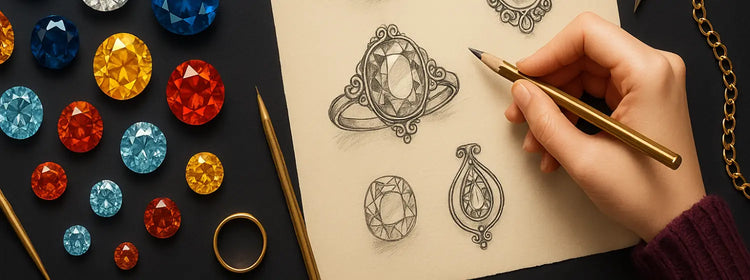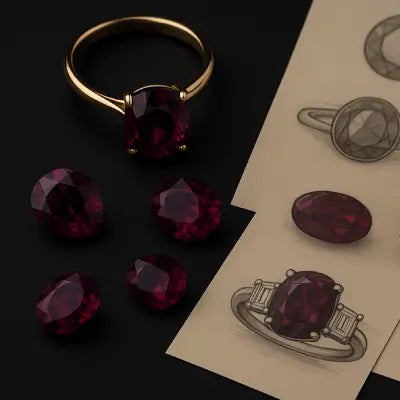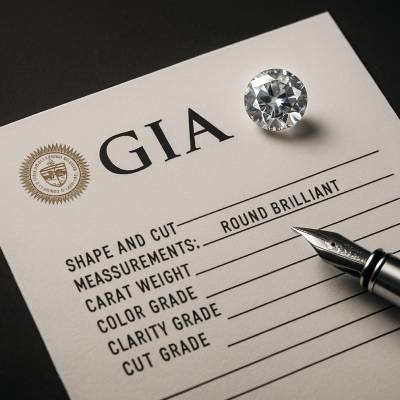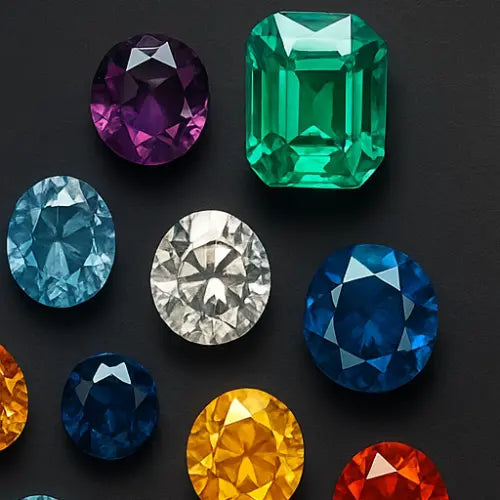You’ve probably heard that each month has a birthstone — but where did this idea come from? Why do certain stones belong to specific months? And do these sparkling gems actually mean anything?
Let’s dig into the story behind birthstones: a blend of ancient mythology, global tradition, and modern symbolism. Whether you’re shopping for yourself or searching for a meaningful gift, understanding the background of these gemstones can turn a simple piece of jewelry into something timeless and deeply personal. This is especially true when choosing Bay Area Handcrafted jewelry, where artisanal techniques and thoughtful design elevate each birthstone’s significance.
Where Did Birthstones Come From?
The practice of linking a single gemstone to each calendar month, rather than rotating all twelve, is believed to have originated in Poland during the 1700s. At the time, Poland had become a vibrant center for trade and scholarship within Eastern Europe. Gemstone merchants in the area began developing a month-by-month stone tradition, drawing from sacred writings, cultural meanings, and the demands of the gem trade.
This region's merchants played a critical role in shaping the commercial gem trade. They had access to both ancient biblical scholarship and an expanding network of European buyers interested in talismans and healing stones. In 1912, the National Association of Jewelers in the United States — now called Jewelers of America — introduced an official list assigning specific gemstones to each month. Over the next century, the list was revised multiple times to reflect the availability of stones and shifting public tastes. Some months have more than one stone.
Personal Symbolism Meets Practical Design
Each birthstone is associated with emotional and spiritual qualities. These associations have varied across cultures and centuries, but the modern chart offers a set of stones widely recognized today.
Yet the appeal of birthstones is not purely symbolic. In the world of fine jewelry, certain stones are valued for more than tradition. Diamonds, rubies, sapphires, emeralds, and alexandrite, for example, hold established positions in global gem markets, appreciated both for rarity and resilience. Others, while visually striking, may be more delicate or abundant, making them ideal for personal use rather than portfolio growth.
Month-by-Month Guide: Stone, Meaning, Use, and Value
Garnet, the stone of January, is known for its deep red color and associations with loyalty and energy. Durable enough for daily wear and available at a range of price points, it suits both casual and formal settings. While not typically a high-yield investment, rare varieties like green tsavorite command collector interest.
Amethyst, February’s birthstone, represents calm and spiritual focus. Once considered precious, it is now widely accessible due to large deposits found in Brazil. Its vibrant color and solid hardness make it ideal for everyday rings and pendants, though its market value remains moderate.
March is linked to two stones: aquamarine and bloodstone. Aquamarine’s oceanic hue and clarity have long made it a favorite for fine jewelry, and its durability supports frequent use. Bloodstone, with its opaque green surface and red spots, carries more historical than financial value but remains a meaningful alternative for traditionalists.
Diamond, Diamond, linked to April, stands out as the hardest naturally occurring gemstone and is prized for its unmatched brilliance. It symbolizes endurance and purity, and its role in engagement traditions has only strengthened its market position. Top-grade, certified diamonds continue to hold strong investment appeal due to their steady demand in markets around the world.
Emerald, the May birthstone, has a rich legacy stretching from ancient Egypt to European royalty. Valued for its deep green hue, the stone is softer than many others and prone to internal fractures, making protective settings essential. Untreated emeralds of fine clarity are among the most valuable colored gemstones in the world.
June stands out for having three designated birthstones: pearl, alexandrite, and moonstone. Pearls, formed by living mollusks, are organic and soft, making them unsuitable for rugged wear but perfect for classic strands and earrings. Alexandrite is especially valued for its remarkable color-shifting properties and is considered highly collectible, often fetching premium prices in the gemstone market. Moonstone is treasured for its soft, otherworldly glow, offering more allure through its romantic appearance than through any significant monetary worth.
Ruby, July’s stone, is rich in symbolism and demand. Its crimson hue represents vitality and passion. Alongside diamond and sapphire, ruby ranks among the most desirable gems globally. Natural, untreated rubies from regions like Burma can reach extraordinary valuations, while synthetic or treated options remain accessible for daily wear.
August is associated with peridot, sardonyx, and spinel. Peridot, with its vibrant green tone, is eye-catching and affordable, though its softness limits its use in rings. Sardonyx, a layered gemstone historically favored for Roman signet rings, has become a niche interest primarily among collectors today. Spinel, often confused with ruby historically, is gaining popularity for its brilliance and durability, with increasing attention from gem investors.
Sapphire, the September stone, is second only to diamond in hardness and has long symbolized wisdom and truth. While blue is the most recognized color, sapphires come in a range of shades and are widely used in engagement and heirloom jewelry. Fine sapphires from Kashmir, Burma, or Sri Lanka often retain or grow in value over time.
Opal and tourmaline define October. Opal’s iridescence has inspired centuries of legend, but its soft structure makes it best for necklaces or protected settings. Tourmaline, available in an astonishing variety of colors, offers more durability and a rising profile in both design and value. Watermelon tourmaline — green, pink, and white in a single stone — is particularly sought after.
November’s gems are topaz and citrine. Topaz ranges from blue to golden-orange, with imperial topaz carrying the highest value. Citrine, warm and golden, is more common and suited to bold, casual designs rather than high-value investment.
December includes turquoise, tanzanite, and blue zircon. Turquoise, with its sky-blue charm, has been used in ceremonial jewelry for millennia, but it is porous and easily damaged. Tanzanite, discovered only in the 1960s, is vibrant and rare, offering strong potential for collectors. Blue zircon is admired for its intense brilliance, but its softness makes it better suited for settings that minimize wear and tear.






